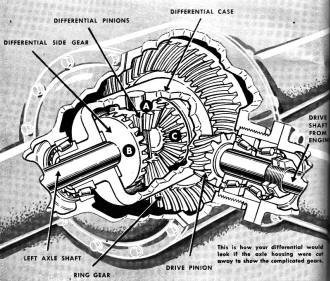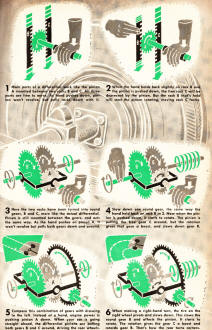|
May 1946 Popular Science
 [Table of Contents] [Table of Contents]
Wax nostalgic about and learn from the history of early
electronics. See articles from
Popular
Science, published 1872-2021. All copyrights hereby acknowledged.
|
Have you ever watched an animated
video of how the differential joint in a car or truck works? Its simplicity required
a spark of genius to come up with. The wheels on the inside of a turn need to turn
at a lesser rate than those on the outside. Recall that for a fixed rotational rate, ωturn
(rad/s), about a pivot point (the center of the turn) and a distance, ωturn,
from the pivot point, the radial speed, sturn, is ωturn*rturn.
Since ωturn is the same for all points along
the radial, sturn is a linear function of rturn.
Assuming the tires are of equal diameter, dtire (or rtire),
the rotational rate, ωtire, of each wheel is sturn/
rtire. Without a differential gear system, then, the
wheels on the inside and outside of a turn would skid due each needing to rotate
at a different rate, but being forced to turn at the same rate. If a picture is
worth 1,000 words, then this video is worth many times more than that. Here is a
great animation of how a differential
gear works. Be sure to also watch the
limited slip differential
video as well. What about electric vehicles with independent drive motors on
the wheels? The computer systems takes care of sensing the rotational speed and
torque requirements for each wheel. Analog versus digital. Like
Joe Walsh of the Eagles, I'm an analog guy.
How Your Car Turns Corners with Differential Gears - Mechanics
of Living
 If your car had to travel only in a straight
line, it could be almost as simple as an oldtime wagon. A basket full of gears,
shafts, pinions. levers, and other parts, front and back, could be discarded. A
steering gear and a few rods could come off the front. But the rear has some complicated
machinery for going around corners. On a turn, one rear wheel needs more speed.
It has farther to travel - like the man on the outside file of a marching column
of men. The other wheel needs less speed; it has to slow down on a turn-like the
man on the inside of a marching column. If your car had to travel only in a straight
line, it could be almost as simple as an oldtime wagon. A basket full of gears,
shafts, pinions. levers, and other parts, front and back, could be discarded. A
steering gear and a few rods could come off the front. But the rear has some complicated
machinery for going around corners. On a turn, one rear wheel needs more speed.
It has farther to travel - like the man on the outside file of a marching column
of men. The other wheel needs less speed; it has to slow down on a turn-like the
man on the inside of a marching column.
So a unit called the differential stands between the two halves of the rear axle
and takes charge of the engine speed. When your car is traveling on a straight road,
the differential divides the engine speed into two equal parts - one to each rear
wheel. When your car turns a corner, the differential divides the engine speed into
two unequal parts. The differential takes some speed away from the wheel on the
inside of the turn, and gives it to the wheel on the outside. Follow the drawings
on the next page and see how the differential works - and how your car turns corners.
 This is how your differential would look
if the axle housing were cut away to show the complicated gears. This is how your differential would look
if the axle housing were cut away to show the complicated gears.
- Main parts of a differential work like the pinion A mounted between two racks
B and C. All three parts are free to move. As hand pushes down, pinion won't revolve,
but pulls racks down with it.
- When the hand holds back slightly on rack B and the pinion is pushed down, the
free rack C will be depressed by the pinion. But the rack B that's held will start
the pinion rotating, moving rack C faster.
- Here the two racks have been turned into round gears, B and C, more like the
actual differential. Pinion is still mounted between the gears, and acts the same
way. As the hand pushes on pinion A, it won't revolve but pulls both gears down
and around.
- Slow down one round gear, the same way the hand held back on rack B in 2. Now
when the pinion is pushed down, it starts to rotate. The pinion is pulling the free
gear C around, but the rotation gives that gear a boost, and slows down to gear
B.
- Compare this combination of gears with drawing to the left. Instead of a hand,
engine power is pushing pinion A down. When your car is going straight ahead, the
differential pinions are pulling both gears B and C around, driving the rear wheels.
- When making a right-hand turn, the tire on the right wheel pivots and slows
down. This slows the round gear B and affects the pinion. It starts to rotate. The
rotation gives the gear C a boost and retards gear B. That's how the rear turns
corners.
Posted November 20, 2023
|










